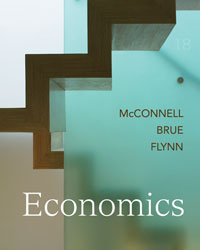
Economics (McConnell), 18th EditionChapter 5: The United States in the Global EconomyOrigin of the Idea
While Adam Smith (1723-1790) saw the benefits to specialization and trade, he did not develop the theory of comparative advantage. Smith's theoretical contribution is known as the theory of absolute advantage. For absolute advantage to apply, each party involved in trade, in order to produce and export a good, would have to be the best, meaning that they could produce, at the lowest absolute cost, the good they were going to export. As explained in the text, David Ricardo (1772-1823) refined Smith's ideas into the concept of comparative advantage, where one could specialize and trade as long as they could produce at a lower relative cost (relative in terms of the other goods they could produce). Ricardo justified his theory using labor costs, specifically in terms of the number of labor hours needed to produce a unit of each good. In other words, a nation's comparative advantage depends on the productivity of the labor used to produce. The illustration of comparative advantage appearing in the text uses opportunity costs, an approach formulated by Gottfried Haberler in 1936. The superiority of Haberler's approach is that it allows for cost differences based on reasons other than relative labor productivity. |  |















